Recent Commercial Posts
Fire Commercial Cleanup Process
10/11/2022 (Permalink)
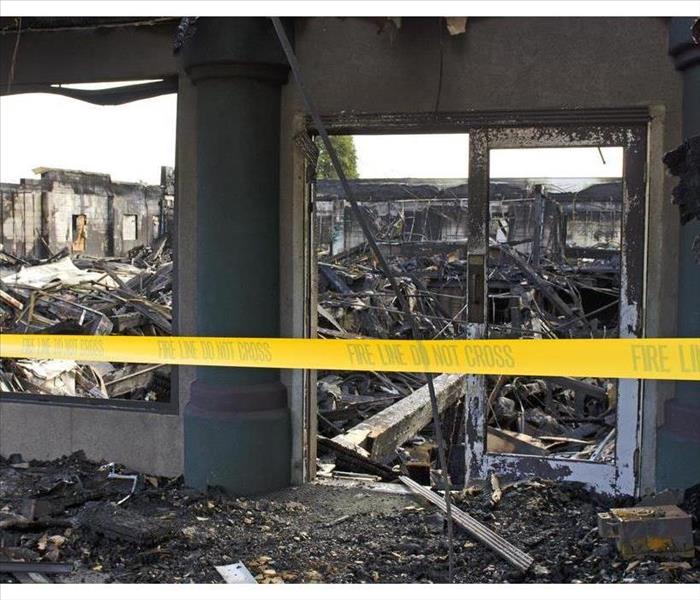 Soot, smoke smell, and structural damage after a fire can all affect your commercial facility.
Soot, smoke smell, and structural damage after a fire can all affect your commercial facility.
When something unexpected happens, you want to be sure that you can quickly restore your business. At SERVPRO of Central Schaumburg/West Bloomingdale, we are here for you 24 hours a day, 7 days a week. We have the training and equipment necessary to clean up any size commercial fire and ensure that it does not cause damage to your building or its contents.
Fire Damages to Your Commercial Building
Fire damages to your commercial building can include soot, smoke smell and structure damage. These are all the effects of a fire that may need to be cleaned. Fire cleanup is the process of cleaning up after a fire has occurred. The removal of debris and rebuilding are also part of this process. Fire restoration is the restoring or repairing of something after it was damaged by fire, smoke, or other means.
SERVPRO of Central Schaumburg/West Bloomingdale is ready to help with a fire in your commercial building by providing 24-hour emergency service, immediate access to water damage restoration specialists who will begin work on controlling moisture as soon as possible and insurance documentation assistance for filing claims on your behalf.
Smoke and Soot Cleanup and Restoration
What is Soot?
Soot is a residue left behind by incomplete combustion of carbon-based fuels. When you burn something like wood, paper or oil in an enclosed space, the smoke generated contains soot particles which get deposited on various surfaces inside your home (such as cabinets, walls, and ceilings).
Call the Professionals to Handle Fire Cleanup in Your Commercial Building.
SERVPRO of Central Schaumburg/West Bloomingdale has the equipment and experience necessary to handle any size fire cleanup in your business.
If your building has been damaged by a fire, don't hesitate to call us. Our professional team will be on site as quickly as possible to remove all traces of smoke and water damage and get your business back up and running as soon as possible.
SERVPRO of Central Schaumburg/West Bloomingdale is Ready to Help with a Fire in Your Commercial Building.
When it comes to fire damage, time is of the essence. You need an emergency cleanup service that can respond quickly and effectively. SERVPRO of Central Schaumburg/West Bloomingdale stands ready to assist with any commercial fire situation. Our trained professionals are ready to come out at any hour of the day or night, even on holidays, weekends and after hours.
We provide immediate assistance when you have a fire in your building so that you can get back to business as soon as possible. A key part of our response is our quick arrival time—we aim for a response within one hour from the time you call us!
SERVPRO of Central Schaumburg/ West Bloomingdale is equipped for any size commercial fire cleanup.
We have been in business for over 20 years, and we're a full-service restoration company. We know how to handle any size commercial fire cleanup. Our technicians are on call 24/7, and they're certified by IICRC (Institute of Inspection Cleaning and Restoration Certification) so you can be assured that your property will be properly cleaned up after every job we complete.
We know that a fire in a commercial building can be devastating, but we are here to help you through it. Our technicians are trained to handle any size fire cleanup, and we offer 24/7 emergency service so there’s no waiting around when you need us most. Call today for more information on how we can assist you with your commercial building after a fire!
Fire Extinguisher 101: Types and How To Use
8/22/2022 (Permalink)
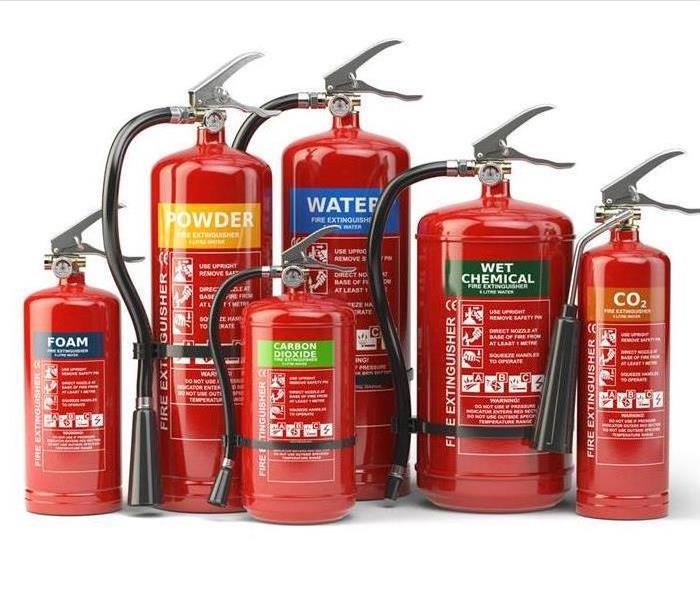 Types of fire extinguishers.
Types of fire extinguishers.
Business owners in Bloomingdale, IL, know how important it is to be prepared. When it comes to fire, ensuring a fire extinguisher is available is essential. Depending on the business and the type of fire, not just any extinguisher will do.
Types of Extinguishers
When it comes to flames a kitchen fire is a whole different situation than one set by combustible materials. Depending on the type of business, having different kinds of fire suppression may be necessary. Below are the general classifications of fire extinguishers based on the source:
Class A – Wood, paper or other combustibles
Class B – Flammable liquid or gas
Class C – Electrical fire
Class D – Metals
Class K – Animal fats or vegetable oils cooking fires
Along with the different classifications, there are different materials released to extinguish the flames.
ABC Powder – A multi-purpose type that sprays a fine chemical powder.
Carbon Dioxide – Removes oxygen from the flames, making it suitable for Class B use.
Wet Chemicals – For use on Class K fires and some Class A ones if it is wood or paper.
Water Mist – Emits de-ionized water molecules via a fog-like mist that are attracted to flames and is effective for Class A, B, C and K.
Foam – Mostly used for Class A and B, the foam expands to suffocate the fire.
Clean Agent – A gaseous suppression option for Class B and C fires.
How To Use
No matter which types are best for your business, all are fairly standard to use. Be sure to examine the unit for any damage before use and verify there is a safe exit route in case it doesn’t work. It’s better to be safe and call a fire damage and restoration company for repairs. Once you are ready to use, simply remember PASS:
- Pull pin.
- Aim nozzle at the base of the fire.
- Squeeze lever or handle.
- Sweep the nozzle back and forth.
Since not all fires and risks are the same, understanding how a fire extinguisher works and the different types available ensures your business is better prepared for the unexpected.
What To Do After a Furnace Flood
6/26/2022 (Permalink)
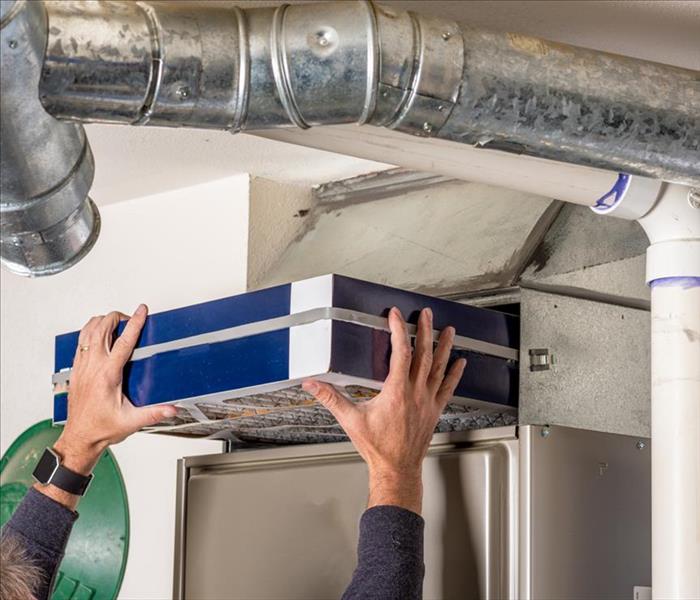 Furnace air filter replacement.
Furnace air filter replacement.
After a Furnace Flood, What Should You Do?
If the basement of your commercial facility experiences flooding, you need to make furnace maintenance one of your priorities. A furnace exposed to water may stop working or even pose fire dangers. Prevent hazards in your Schaumburg, IL, business after a furnace flood by following these tips.
1. Prevent Further Flooding
Leave the flood site if it's not safe. To prevent further flooding, shut off the water to your building. You will also need to cut off electricity in flooded areas to avoid electric shock hazards.
2. Remove Water
Start removing water as soon as possible with a water remediation company. Their technicians have the knowledge and equipment to pump out water, dry out your business building and assess the site for damage. They can also check appliances to determine whether they need repairs.
3. Prevent Furnace Flood Hazards
Contact a professional to inspect your furnace before using it following water exposure. Though the furnace may seem functional on the outside, there may be internal problems you can't detect. A damaged furnace could develop the following hazards:
- Fungi and mold formation
- Fires
- Carbon monoxide emissions
Damage to a furnace's interior parts could lead to the release of carbon monoxide, a poisonous gas undetectable to human sight or smell. Moisture trapped within the furnace could also create an ideal growing environment for mold and mildew. If the furnace filters become obstructed, the furnace could malfunction and start a fire.
4. Clean and Repair a Flooded Furnace
Your furnace's maintenance needs will vary based on the level of water exposure and damage. It may only require air duct cleaning or filter changes. Severe damage could entail the replacement of the whole furnace. Some water remediation agencies offer furnace maintenance services, including cleaning the air ducts and air filter replacement.
Don't feel overwhelmed over how to begin post-flooding restorations. Use these tips to get back in business after a furnace flood.
What To Expect From the Commercial Fire Cleanup Process
5/30/2022 (Permalink)
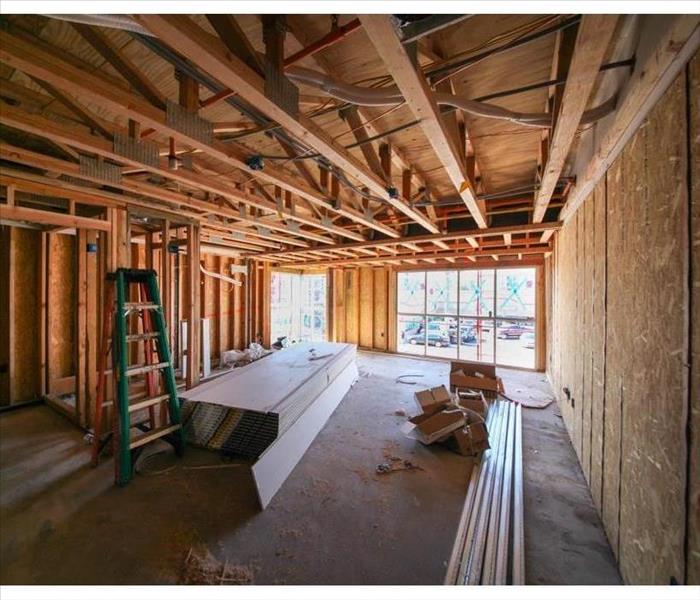 Commercial fire cleanup in Glendale Heights, IL.
Commercial fire cleanup in Glendale Heights, IL.
Commercial Fire Cleanup Process
Weathering a fire at your business in Glendale Heights, IL, can be an overwhelming experience. As soon as the firefighters extinguish the blaze, you will probably wonder what happens next. After all, this is not an everyday occurrence. Direct damage from the flames, as well as water, smoke and soot damage, and possibly even structural damage, must be restored. Depending on the amount of damage your property sustains, the post-fire cleanup process can be very involved. After the fire is put out and everything is under control, you can typically expect the following cleanup process:
1. Assessing the Fire and Smoke Damage
First, fire damage restoration professionals will arrive to thoroughly assess the damage. They will determine the extent of loss and create a remediation plan.
2. Preventing Additional Damage
Once a plan is in place, the technicians will do everything possible to mitigate the fire and smoke damage. This often includes shutting off the building's electricity and water to prevent further loss, such as an electrical fire.
3. Cleaning All Surfaces
The restoration team uses industrial equipment and expertise to clean the entire area affected by the fire. All surfaces will collect dust and other debris, and the smoke and soot will likely impact them. In addition to smoke cleaning, a significant part of the cleanup process involves water damage restoration because firefighters typically use many gallons of water to extinguish a building fire.
4. Performing the Restoration Process
The restoration experts will do everything possible to return the affected property to its pre-fire condition. A big part of this process is using air scrubbers and other equipment to clean the air and eliminate smoke odors.
When a commercial building catches fire, remediating smoke damage is a significant part of the cleanup process. It's helpful to have a restoration company listed in your emergency contacts to call if the worst happens.
Avoid Mold Cross-Contamination Through Containment and a Professional Response
5/20/2022 (Permalink)
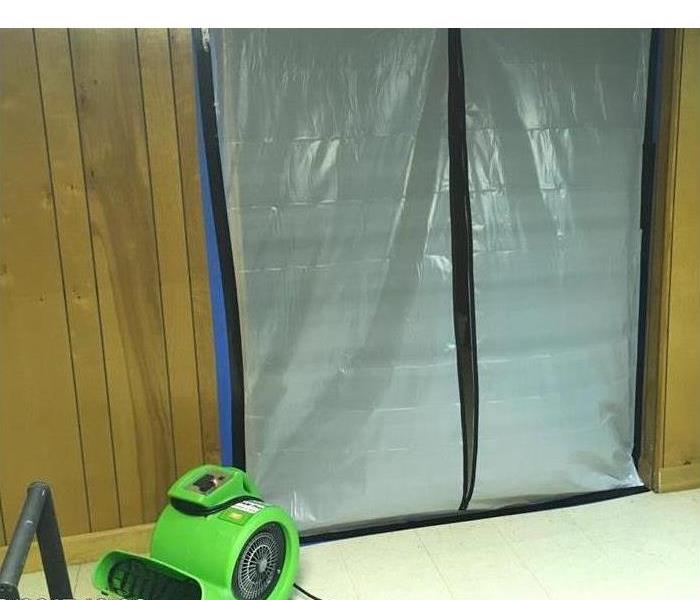 Containment for mold.
Containment for mold.
Containment and a Professional Response Can Help Prevent Mold Cross-Contamination
Mold cleanup can be a particularly tricky task because of the potential for cross-contamination. This is especially troublesome if mold contamination has closed down part of the commercial property, and there's concern that other parts may get shut down as well. Sadly, when property owners turn to DIY cleanup efforts, spores are often transported to previously unaffected areas. Rather than risking the spread of spores, it's best to turn this task over to Keeneyville, IL, professionals.
The First Containment Efforts
When you first notice the mold problem, reach out to mold cleanup and remediation professionals. These technicians have the training, equipment, and necessary supplies to avoid spreading spores. As you wait for the professionals to arrive, there are a few steps you should take:
Cordon off the affected area. If possible, completely cut off access to the area. Closed doors may prevent spores from traveling beyond the area as well as discouraging people from walking through.
Limit traffic in and out of the contamination zone. Spores can easily travel outside of the affected area on shoes, clothing, or even a slight breeze.
Turn off the heating and cooling system. HVAC systems are efficient at providing ventilation, but they are equally efficient at housing and carrying mold spores throughout the entire building.
Once these steps are complete, it is safe to wait for cleanup technicians to arrive.
Professional Cleanup Methods
Technicians take further steps during cleanup to keep mold contained. These include wearing protective gear, such as boots, gloves, and filtration masks. If necessary, they will further seal off the affected room or rooms with plastic sheeting. Sometimes, exhaust fans are required to provide ventilation that only moves toward the exterior of the building. Technicians use airtight plastic bags for removing affected items and may create a decontamination zone.
Thorough mold cleanup requires swift containment efforts. It is also a project with the potential for many mistakes and should be turn over to professionals as soon as possible.
Steps To Remove Commercial Mold
4/8/2022 (Permalink)
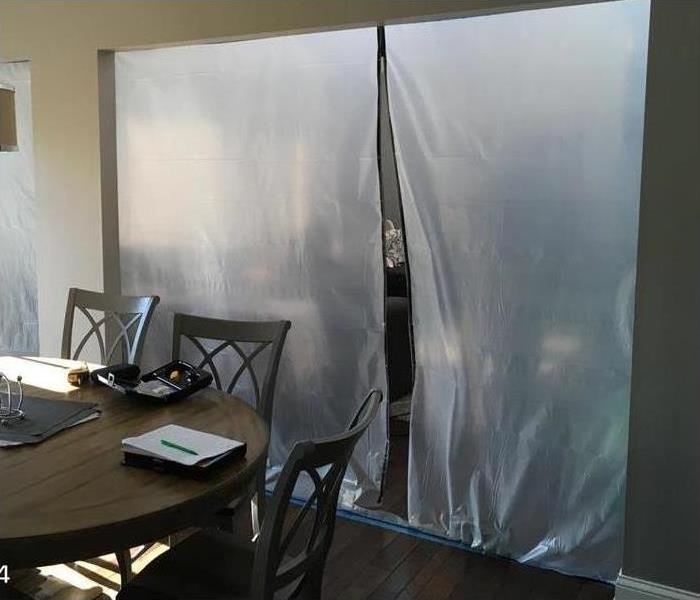 Mold containment in Hanover Park, IL.
Mold containment in Hanover Park, IL.
Mold Remediation
Mold loves moist, dark areas in your commercial building. If left unattended, mold growth can cause extensive damage to your facility in Hanover Park, IL. To eliminate a mold problem, it’s important to understand the typical steps involved in mold remediation.
1. Call an Expert
Don’t try to clean up the mold yourself. Contact a mold remediation expert as soon as possible to lead the effort. The professionals will follow the steps below, as necessary.
2. Assess and Inspect the Facility
Professionals assess the situation by looking for water damage and mold using technological equipment.
3. Contain the Mold
High humidity can trigger further growth quickly, so experts use containment procedures to reduce the risk of spreading mold. Negative air chambers are used to keep affected areas from contaminating other areas. HVAC systems and fans are turned off to discourage mold growth.
4. Utilize Air Filtration Equipment
Air filtration systems help capture and remove mold spores from the air, along with HEPA vacuums and air scrubbers.
5. Remove Moldy Materials and Clean Surfaces
The amount of mold remediation necessary depends on the amount of mold and the texture of the surfaces. Applications using antimicrobial treatments eliminate colonies of mold and reduce the likelihood that they will return. Porous materials containing mold are carefully removed and disposed of properly.
Materials that can be salvaged, such as drywall, furniture and carpeting, are cleaned and sanitized using specialized cleaning techniques. Odors can also be removed from these materials with deodorizing treatments and fogging equipment.
6. Restore the Premises
The level of restoration is dependent on the amount of damage to structures and surfaces. For example, restoration might only include replacing a few sheets of drywall or installing new flooring. If subfloors or other key structures are damaged, major reconstruction may be necessary.
If you are concerned about mold growth in your building, don’t hesitate to call a professional right away.
Does Commercial Insurance Cover Storms?
2/1/2022 (Permalink)
 High winds can cause damage to your commercial roof.
High winds can cause damage to your commercial roof.
Does Commercial Insurance Cover Storms?
Commercial property insurance policies cover many types of storm damage. Owners of buildings in locations prone to hurricanes or flooding may want to consider an additional storm insurance policy or rider on an existing policy. Find out more about covered perils and which exclusions or limits to look out for in a policy.
Hail and Wind Damage
Most general commercial property policies cover damage caused by hail and wind. These conditions may result in several forms of damage to roofing materials:
- Bruises
- Cracks
- Dents
- Punctures
Be sure to document damage before tarping over or taking other mitigation measures. Insurers are more likely to cover a claim if the owner can prove a roof was in good condition prior to a storm.
Leaks and Flooding
If a roof leaks due to damage sustained during a storm, commercial property insurance should cover the damage as long as the roof was previously in good condition. Flooding caused by the following conditions is not covered by most commercial property policies:
- Heavy rain
- Rising bodies of water
- Sewer backups
Supplementary flood or storm insurance policies or endorsements will be necessary to cover damage caused by accumulating rain. Heavy rain can also cause municipal sewer mains to back up into buildings. Additional sewer coverage may also be necessary.
Hurricanes and Tornadoes
Hurricane damage is cut out of many commercial property policies or may be subject to special insurance coverage requirements such as percentage deductibles based on property value. Property owners may want to seek additional coverage. Most policies cover damage caused by tornadoes, but policyholders should purchase a sufficient amount of coverage to compensate for a total loss.
Many types of storm damage should be covered by a commercial property policy for a building in Roselle, IL. Flooding, hurricanes and sewer backups may require additional storm insurance to offset the costs of commercial mitigation and restoration.



 24/7 Emergency Service
24/7 Emergency Service






